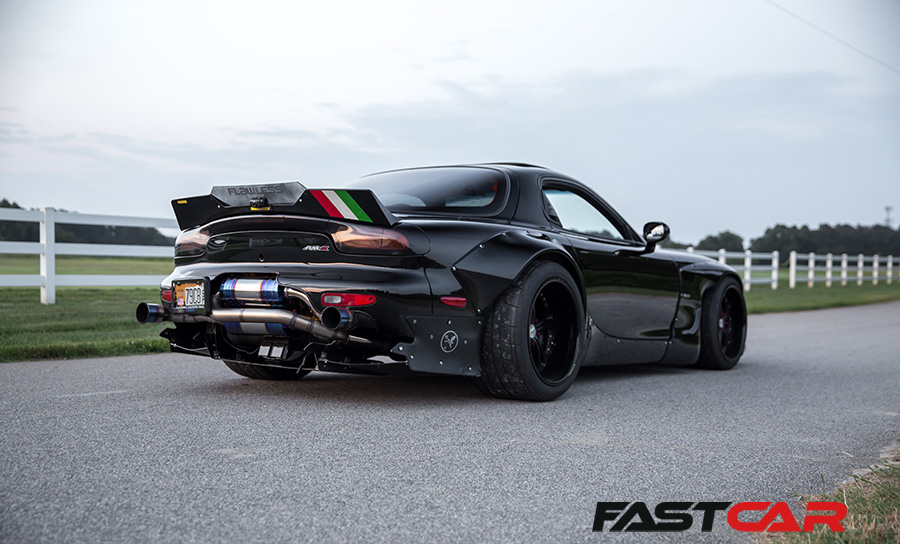One of the best Japanese performance cars ever made, the FD Mazda RX-7 is tuning gold, so long as you do it right…
Easily the best known of all Mazda’s rotary engine vehicles, the FD RX-7 was a high-tech and stunning looking sports car. It was was way ahead of its time when first released in 1992. In the 30 years since, it’s aged well in both looks and performance. Most importantly for us, though, it has a massive tuning scene behind it.
Produced for ten years up until 2002 with only relatively minor changes, only one power unit was available; the 13B-REW two rotor twin turbo engine. That thing uses a complex sequential turbo system that allows one turbo to be making boost from barely over idle. As the revs rise, the second turbo comes into action all the way to the red line, giving the car a very wide rev range.
Aside from the well-known engine and obvious good looks, the standard car has good braking and handling abilities. Even factory-spec cars can hold their own against even today’s cars. When you combine all of those traits together, it’s easy to see why the Mazda RX-7 FD is such a brilliant base for tuning.
FDs are popular in all forms of motorsport, especially drag racing, drifting, and time attack. Often top contenders in their class even today shows the potential of these cars.
Unfortunately, another of the best-known aspects of the FD RX-7 is the reliability issues of the rotary engine. However, as countless successes and records in motorsport hints at, the engine is capable of handling huge power without trouble. You just have to do things correctly, and hopefully this Mazda RX-7 FD tuning guide will help guide you in the right direction.
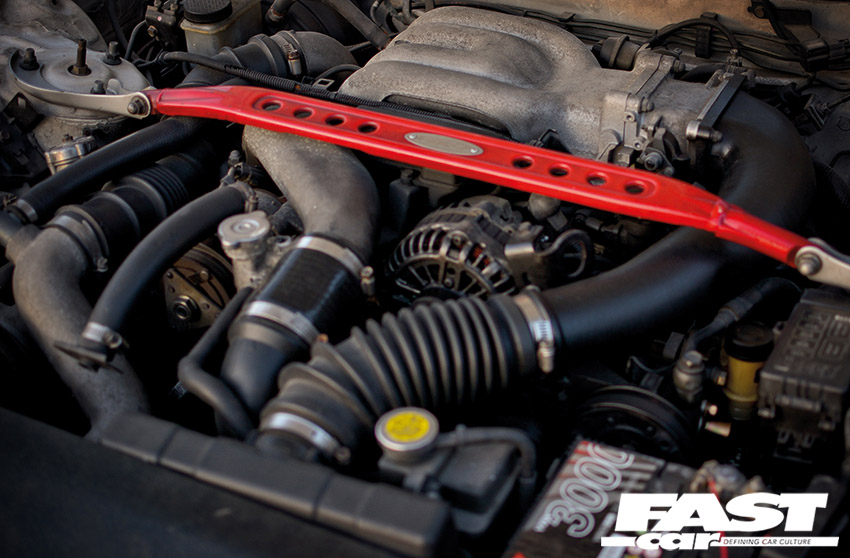
Mazda RX-7 FD Tuning: Engine Upgrades
The FD’s 13B-REW twin rotor twin turbo engine featured between 252bhp and 276bhp from the factory between various model years. From a tuning point of view, it really doesn’t matter which you start with. Regardless of your base canvas, you could end up with four-figure power numbers, either using the standard rotary or one of the many popular engine swaps.
Mazda RX-7 FD Tuning: Exhaust
Just like any turbocharged engine, restriction and backpressure is a bad thing. In theory, the best exhaust is no exhaust. In reality though, hearing loss and carbon monoxide poisoning are concerns, so let’s fit a shiny pipe to your FD.
The main considerations on an FD RX-7 that sets it apart from a typical car comes from the fact that the rotary engine design creates a massive amount of high energy exhaust gas. This means not only does it benefit from a larger than expected exhaust system, but also the exhaust will tend to be very loud versus the same system on a piston engine. This, combined with a chassis which doesn’t have a lot of room underneath for large silencers, makes for some important exhaust considerations.
The factory exhaust is 2.5 inches in diameter. While that’s big versus many OEM vehicles, that’s small and restrictive for a twin turbo rotary. For mild states of tune, a typical off-the-shelf 3-inch system will be a good upgrade over standard in both flow and sound. Beware that the noise of many of these will already be beyond track day DB limits. While tailpipe bungs are commonly included, they will make the exhaust more restrictive than standard when fitted; perhaps dangerously so.
Just like all turbocharged engines, the downpipe tends to make the biggest performance difference. If your goal stretches beyond mere looks and noise, make sure the exhaust is a full system from the turbos back. From a price point of view, prices can be from as low as $400 / £350 for an unbranded system to over $1400 / £1200 for one from a top Japanese tuning company.
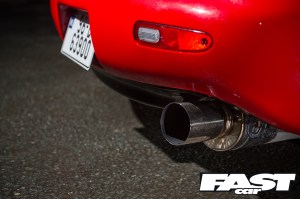
Exhaust options for over 500bhp
When your goals are upwards of 500bhp, a 3-inch system will likely be holding you back. While there are a few 3.25- and 3.5-inch systems available off the shelf, they’re certainly less common. Of course, a downpipe intended to fit the original twin turbo setup will not fit a single turbo converted car.
In this case, by far the most common solution is a custom-made exhaust system. A 4-inch turbo back is generally the way to go. On hard core big power drag FDs we’ve seen as large as 5 inches! You can rule out passing most track day noise tests with a typical system. However, there is room for a medium sized silencer in the middle of the chassis and a fairly large one at the rear.
If a relatively quiet exhaust is still your goal, it’s possible with some clever fabrication. Price wise for this, expect at least $800 / £700 for a basic 4-inch straight pipe custom exhaust, to upwards of $1700 / £1500 for a twin silencer system. It’s also worth bearing in mind, an external wastegate vented to atmosphere, while incredibly loud at full boost, makes for a far freer flowing exhaust than one that recirculates back to the main exhaust system to reduce noise levels.
If you wish to run the car at all times with a catalytic convertor, the key is to get as large and as free flowing one as possible. You may struggle meeting emissions limits with a 100-cell race cat. Once up to temperature, most 200 cell cats will pass. The key will be to get as large a diameter as possible. No matter how wide the cells are, it’s not as free flowing as a plain pipe or straight through silencer.
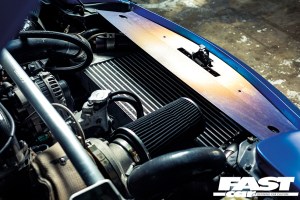
Mazda RX-7 FD Tuning: Intake
From the factory, the twin turbos draw air through a single plastic air box. While it’s a completely sealed unit meaning it’s good for cold intake temps, enough air is far more important for performance than cold air. It’s almost universally changed for an aftermarket upgrade on any non-standard FD.
For the factory twin turbo set-ups, you have two main options. A freer flowing air box design, or twin cone air filters. When it comes to air boxes, the ARC one is perhaps the best known. Though it’s no longer in production, CX Racing sell a copy of it for around $250. The other option is something like the ultra-cool carbon fiber one from Auto-Exe. Like most carbon fiber parts, it’s far from cheap. It’ll likely to set you back over $1000.
The other, most common, option is twin cone air filters. Granted they in theory suck in hotter air, but in reality, on the road and track the difference is negligible. All the usual popular manufacturers make cone filter setups for the OEM twin turbo system. Japanese brands HKS, Blitz, and Tomei are especially common and cost around $300 for a full kit.
Custom air intakes
When it comes to single turbo converted cars, your intake will be custom. Generally, they are simpler and cheaper than the factory twins. Without creating a restriction it’s very hard with the room available to run an effective air box. As a result, almost all single turbo FDs, even high-end race cars, run open air filters. Your options here are purely down to where you want to mount the filter. Some fit it directly to the compressor inlet of the turbo and some will add a silicone or alloy bend to mount it elsewhere. Temperature testing of this position has shown there’s little difference, so it’s a case of space and cosmetic choices. For a filter, while HKS mushroom filters are still common, a much larger RamAir or K&N cone filter can be easily purchased for $150 or less.
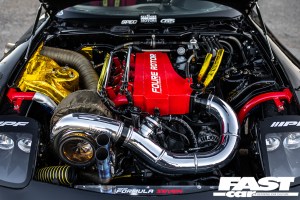
Mazda RX-7 FD Tuning: Turbo Upgrades
While the factory twin turbo setup is a trick bit of kit, it’s not capable of much more power in factory form, so an upgrade is a must. While upgraded stock position turbos exist (the best-known supplier of these being Knight Sports) – and most turbo specialists would be able to make hybrid turbos from your standard units – unless you’re determined to do this, it’s rarely seen to be worth it.
Factory style hybrid twin turbos rarely achieve 400bhp. Plus, you still have to contend with the incredibly complex and often troublesome control system for the sequential turbo setup. It’s possible to run the turbos in parallel mode, deleting most of the complicated setup that’s often unreliable with age, but then you lose any spool advantage of that setup. As a result, making it relatively pointless unless you’re determined to keep a standard look.
Big single turbo upgrade
While you could build a fully aftermarket twin turbo setup, by far the best solution is to go for a big single turbo. There are countless parts on the market to fit this route. There are complete kits from the likes of SAS Autoworks, Turblown Engineering, IRP, PAC Performance, HKS, and many more, to individual turbo manifolds from the likes of Walton Motorsport and countless others. Often the complete kits can cost upwards of $5000 for a top quality and comprehensive kit. A good manifold alone generally costs you between $700-1500.
While parts are easy to source, the most important thing with an RX-7 turbo kit is getting the right setup for your goals and needs. Being twin rotor, a divided twin scroll turbo setup is generally highly beneficial with regards to spool over a single scroll turbo and manifold. However, from a peak power point of view there’s not a huge change. While turbos with V-band turbine inlets are massively easier to fit and generally more compact, these are almost solely single scroll units. The ease of fitment becomes a trade off with spool that most don’t consider worthwhile.
Finally, and most importantly, is actual turbo choice. We’d need to write an entire book on this to truly cover it in full detail, but there’s a lot of things to consider when it comes to turbo choice. It’s very different to your typical piston engine.
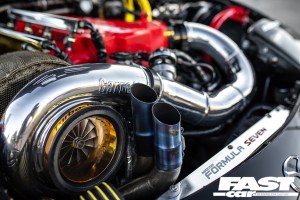
FD RX-7 turbos for street use
Firstly, due to the rotary engine’s design giving a huge amount of high energy exhaust flow, you can use – in fact, you need – a surprisingly large turbo size. This is particularly true on the turbine side, for any given power level. Rotary engines have no issue spooling up large turbos. Generally, a turbo such as Garrett G35 or EFR7670 (things with compressor inducers of around 60mm) are the smallest ones to even consider. They will still need to use one of the largest turbine housing options available for them to not massively choke up the exhaust side of the engine. These setups will give ultra-fast spool and up to around 500bhp, while generally making peak power around 6000-6500rpm. This makes for a very torquey and almost un-rotary feeling engine, but you can go much bigger.
The most common size for rotary turbos on street cars tends to be a little bigger than the ones mentioned above. Various BorgWarner S300 series and EFR turbos (with compressor inducers around the 65mm mark) proving to be very popular. Again, these require one of the larger turbine housing options as it’s turbine flow that is usually maxed out long before compressor flow on a rotary engine. These, providing you’ve got the engine and supporting mods to cope, are common in the 500-600bhp region. While they don’t spool as fast as the smaller turbos, they’re far from laggy. They also have plenty of mid-range, and make up for any loss of low-down power by pulling hard well in to the 7000rpm range.
RX-7 FD turbos for over 550bhp
Bigger than this seems extreme, but due to the rotary engine design, it’s surprisingly usable. Rotaries like to rev, rpm is what makes them come alive. The lack of inertia and vibration means even from the driver’s seat very high rpm feels like low rpm compared to a typical piston engine. Combine that with the amazing ability for a rotary to spool a turbo, and you’ve got the potential to run what seems like a gigantic turbo with perfectly good road manors. At this level it gets hard to explain without experiencing it, but anyone who’s been lucky enough to experience it tends to say the same thing; the gains far outweigh the drawbacks.
First of all, there’s truly no reason to go this big unless you want over 550bhp and have supporting mods. That means internal and external mods that will allow power at high rpm. If you want big power and big rpm, it’s perfectly possible on a street drivable car. As you may have guessed, a big turbo doesn’t hit full boost until much higher in the rpm, but a correctly designed setup still makes positive boost from low rpm – more than enough to make it very drivable. Then, when you want to go insanely fast, simply drop a gear and you’ll be off like an absolute rocket with the engine happily screaming to 8500rpm plus. While you may lose 500-1000rpm from the bottom of your power band versus a smaller turbo, you’ll often gain 1000-1500rpm up top on a rotary.
Don’t expect diesel levels of low down torque
The final thing to consider here is the rotary is an inherently revvy engine. No matter what you do, you’re never getting diesel-like low rpm grunt. Even the smallest turbo setup will come alive as the revs rise beyond 5000rpm, despite full boost happening long before that moment. Because of this, even comparatively huge turbos with a 70-75mm turbine wheel exducer size – which are generally rated to over 1000bhp (on a piston engine) – can be perfectly usable on the road if combined with an equally large turbine housing.
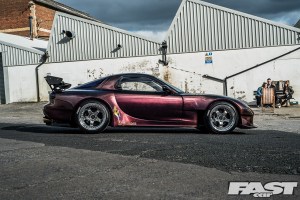
Mazda RX-7 FD Tuning: Fueling upgrades
RX7s love fuel. And by that, I mean they naturally drink a lot of it, and if you don’t give them enough of it, you’ll be needing a new engine in a matter of seconds. As standard they run two 550cc injectors and two 850cc injectors, which sounds large, but in rotary terms, it really is not. Beyond very mild upgrades, increase injector size; this can involve just two or all four, depending on your goals. Even huge 1600cc+ injectors are not uncommon, but prices stay similar regardless of size, so this will simply be a case of choosing sizes big enough for your goals.
If going to extreme power levels, especially if using E85 or methanol as a fuel, four injectors regardless of size may not do the job, but thankfully the rotary drag racing scene is so popular that there’s aftermarket inlets out there with eight and even twelve injector ports on them, allowing for truly insane amounts of fuel.
Of course big injectors need big fuel pumps to feed them, and while you can relatively easily fit a direct replacement pump from Walbro or similar into the tank which can handle respectably large power levels, companies like Radium actually make a dedicated fuel system that mounts inside the factory fuel tank. This bespoke solution incorporates up to three high flow fuel pumps, and has a fourth lift pump supplying fuel to the in-built surge tank, allowing enough fuel no matter what your goals are.
Pump fuel and E85
Lastly on the subject of fuel, what fuel you use is hugely important, as the rotary design means they are incredibly susceptible to detonation. Overall, they are strong engines, but detonation is the number one killer and why they often have a reputation for being weak and unreliable. Fuel related detonation from running overly lean results by a few factors: incorrect ECU remapping is most common, an inadequate fuel system of course, or simply trying to push the octane limit of your chosen fuel type too far.
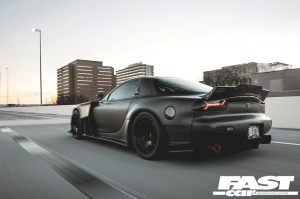
The true power limit of pure pump fuel on a rotary is a very touchy subject with countless variables and even more opinions, but the simple fact is, to help prevent detonation you can either swap to a higher-octane fuel, add a secondary fuel, or inject water. A higher-octane fuel can make it much easier to make massive amounts of reliable power, but it makes it harder to be a true road car, especially in the UK where we don’t get E85 at the pumps like some countries.
If you run a flex fuel sensor it’s possible to have your ECU mapped in such a way that power is automatically increased or decreased in accordance with the amount of ethanol or methanol detected in your fuel lines. This means you can pour it into your fuel tank as a mix on occasions when you want to make big power, but still means you can run it on normal pump fuel when required.
Water Injection
Water injection is very popular on rotaries as its job is to help resist detonation, and while it’s not technically fuel, it’s totally inflammable, so technically it has unlimited octane, and done right can have a massively useful effect. Aquamist, AEM, and Devils Own are all popular brands of water injection kits, but there is a drawback, and that’s how much you’d need to inject to have a worthwhile effect.
Many people who have water injection kits honestly inject so little that the effect is more of a placebo than a true help, but as it’s not combustible, there’s only so much you can inject before it literally puts the fire out and causes the engine to misfire. It is counteracted somewhat by running particularly powerful ignition systems and/or placing the injection nozzle(s) in ways that help vaporize the water more before it reaches the engine. However, there’s still only so much you can use.
Creating a water/methanol mix increase the amount possible before misfire. A mix of up to around 55% water and 45% methanol is still flammable even as a non-vaporized liquid, and there’s almost no limit to the amount of methanol used without causing a misfire.
Dual fuel system
The final way to do things is the most complex, but overall best for a road car, and that would be a dual fuel system. There a couple of ways to do this, but the result is the same. Running the car on normal pump fuel is possible, but as rpm and boost is increased, a secondary race fuel, most commonly pure methanol, is injected via the second fuel system, allowing potentially the same performance as a full drag race engine, but still perfectly drivable on the street.
The main advantage here is you’re only using race fuel when the engine needs it at high boost, so for a very short percentage of the running time on a typical road car, meaning an amazingly small amount is actually used, saving you money and making it easy to top up the secondary system at home. The first way is with a complete secondary electronic fuel injection system for the race fuel, which is complex, but well proven.
Other fuel system options
The second way is a mix between that and a typical water injection setup, and it’s been done with great success over the years by rotary legend Rice Racing in Australia, with multiple atomising nozzles rather than electronic fuel injectors. This may sound more basic, but injection when on boost, especially with large amounts of methanol, doesn’t need to have the precise control EFI gives, as that’s mostly useful for drivability at light throttle and load, and the simplicity of this setup means cost savings and less potential failure points with no real downsides.
Regardless of fuel system choice, the key to reliability is to build it well and to install as many engine safeguards into it as you can, as if the system fails detonation will still happen in seconds.
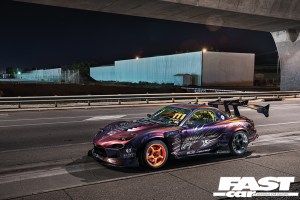
Mazda RX-7 FD Tuning: ECU Upgrades
As with almost all factory Japanese units from the 1990s, modifying the FD RX-7’s ECU isn’t worthwhile, so for any real power increases an aftermarket ECU is required. There are various plug-and-play ECUs available for the RX-7, with Haltech and Link being very popular at the moment.
While some ECUs have more capabilities than others, there’s a saying which goes along the lines of, “An ECU is only as good as the person who maps it”. What this means is twofold. First, it’s relatively rare that you’ll make use of the most sophisticated functions featured in high-end ECUs. Secondly, you can have the best ECU on planet earth, but if it’s mapped poorly your car won’t be anywhere near as good as one with an incredibly basic ECU mapped by someone who knows their stuff.
Poor mapping can lead to engine failure
This is more important on rotaries than any other type of engine, as not only do they require very different tuning parameters compared to the piston engines most are used to, but one mistake that allows any detonation and the engine can fail. In fact, detonation from either lean running or too much ignition timing – both usually down to the settings in the ECU map – is why the vast majority of tuned rotaries fail.
Many regard knock detection on a rotary engine to be pointless, as while it’s a vital reliability tool on a piston engine, by the time most have detected it on a rotary it’s too late and the engine has failed. That’s not to say knock detection cannot work on a rotary. Mazda fitted it as standard, and some tuners have proven it can work very well, but again, that’s a very particular skill set that most do not have.
There’s plenty of examples of big power rotaries reliably making power on practically prehistoric ECUs like the Apexi Power FC, while many others running modern high-tech units fail before they leave the dyno. This is nothing to do with how good or not the ECU is, this is purely down to the person who’s mapping it.
Choose your mapper wisely
Choosing who you want to map your rotary is possibly the most important decision of all. Your options will be relatively low as the majority of mappers will have had no real experience on a rotary engine, which should rule them out straight away. Beyond that, the key would be proof of what they’ve done already. It’s easy to make big power on a dyno, but big power with hard use and reliability is the true goal, and if you can find that person, you’re in for a much better time than the rotary reliability myth suggests.
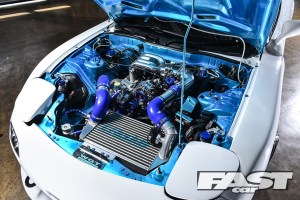
Mazda RX-7 FD Tuning: Cooling Upgrades
While rotaries create a lot of heat, and we mean a lot, generally the RX-7 cooling system is well designed for both the oil and water systems, so wild changes thankfully aren’t needed. Uprated alloy radiators are widely available that are a direct swap for the often old and brittle original unit, so that’s never a bad thing. Uprated oil coolers are an option too, but make sure you have an oil temperature gauge and know your oil is getting too hot before you upgrade these, as the stock oil cooler setup is actually very effective, and over-cooled oil is potentially more damaging than overly hot oil.
One part of cooling that does need improving once you do almost any engine tuning, is the charge air cooling, AKA fitting a better intercooler. Front mount intercooler kits are widely available that are adequate for the majority of cars, especially with water injection helping keep temperatures in check a little. The really big power cars tend to have fully custom setups of a gigantic intercooler or chargecooler, which will need custom pipework and mounts, and potentially a complete custom intercooler – but that’s something any good alloy fabrication shop with intercooler experience can take care of.
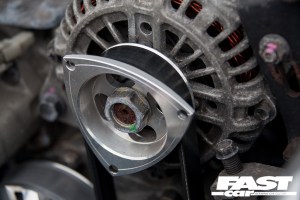
Mazda RX-7 FD Tuning: Engine Internal Upgrades
The rotary engine is wildly different to piston engines in every way. There are only three main moving parts in a two rotor. Those are the rotors themselves, and the eccentric shaft (rotary version of the crankshaft). Also, despite the rotary unreliability stories, all these main parts are incredibly strong. In recent years, billet housings and plates have become available, the factory rotors and eccentric shafts are often used even on some of the most powerful rotaries ever made. That’s not to say you should just leave the engine standard though. Not only does it contain some of the most fragile components, but the rotor housings and plates are also where the inlet and exhaust ports are located. Modifying these is hugely important on a rotary, even more so than a typical piston engine.
There are no camshafts or valves on a rotary. The intake and exhaust ports don’t open as such, they are instead covered and uncovered by the movement of the rotors. So, to adjust when and for how long the ports are open, not to mention their overall maximum flow rate, you need to change the shape and size of the ports.
Almost every rotary tuner has their own variations and opinions on port designs. The common versions for intake porting are street port, bridge port, semi-peripheral port, and full peripheral port. Street port basically means enlarging of the stock ports. It’s vague as you could potentially only mildly change them or go absolutely wild. This is why you see people say, ‘small street port’, ‘large street port’, and so on. Generally, these give an almost stock idle and low rpm drivability while giving a good overall performance increase. However, larger ones would certainly affect idle and low rpm somewhat in exchange for even more peak flow.
Rotary street and bridge porting
For 500bhp-plus, or just because you want the cool sounding idle, a bridge port is the way most people go. Like street port, these can vary wildly in size depending on preference, and can even be done as a semi-bridge where only half the ports are bridge and half are street. A bridge port is effectively a street port with a secondary long thin extra port just outside of it. The reason for it being two rather than one huge one, is the metal left between the two ports allows the rotor’s corner seals to travel across it, hence the name bridge. If there was nothing there, the corner seal would simply fall out and the engine would not run.
Bridge ports can vary between ones purely done to get the famous ‘Brap, Brap’ idle many customers want, right up to seriously large setups on drag cars making power in the four-figure region. Idle quality and low rpm performance will again depend on how hardcore the porting has been, but most will have at least a slightly higher than standard idle and less low rpm power. Some larger bridge setups are screaming high rpm monsters, with over 11,000rpm being possible on the right engine.
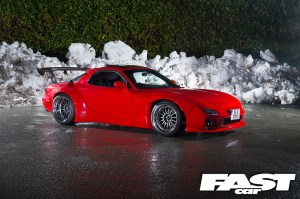
Semi-peripheral porting
Next up is semi-peripheral porting, which is actually two more ports added via some machining to the peripheral of the rotor housing itself, rather than the original ports which are on the plates either side of the housing. Again, this is quite a vague description, as not only can these ports be of varying sizes, but the original intake ports will also generally be ported either street or bridge style. The advantage of semi-peripheral is of course more air flow, but if used in conjunction with a street port it has the advantage of not potentially reducing corner seal reliability while still giving huge airflow levels. As you may expect, with two more ports you need a different inlet manifold to suit, but thankfully there are off the shelf ones available from various RX-7 tuning specialists around the world.
Full-peripheral porting
Last, rarest, but certainly not least, is a full peripheral port. In this situation the factory side ports are sealed shut with high strength epoxy resin, and a single huge intake port is added directly to each rotor housing. This large and direct route for the airflow is by far the best for power, but idle speed is often 1800rpm+, low-down power is greatly affected, and noise is massively increased, all in exchange for huge high rpm power. This setup is usually reserved for naturally aspirated rotaries, as when you have a turbocharger forcing the air in, the other smaller ports can generally make all the power you’ll ever need. But that’s not to say it’s impossible!
What’s less commonly talked about is exhaust porting. The exhaust ports are already large and of a peripheral style, but they are still ported to various levels to change flow and timing, with the porting generally going more extreme in tandem with how wild you’ve gone on the inlet side.
Other engine internal upgrades
Away from porting, there’s various upgrades that are done to the engine internals such as uprated studs, lightened rotors, uprated corner seals, and of course the infamous apex seals. Apex seals are the rotary equivalent of piston rings, in the fact that they are the key component that gives the engine it’s compression, and if they fail the engine will not run.
There are countless variations of apex seals available, and you’ll find every tuner has different opinions on what’s best, but generally there’s a trade-off no matter which ones you use. Some are harder than others so can withstand high temps and detonation a little better, but sometimes with the side effect of increased wear on housings and worse damage to other components if they do fail. Some are made to be very flexible, so if detonation does damage them, they simply bend rather than snap or shatter, causing less damage to other components.
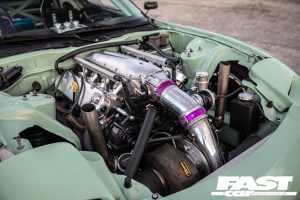
Mazda RX-7 FD Tuning: Engine Swaps
While it’s frowned upon by the purists, and many people feel it takes away part of the driving enjoyment to do so, there’s no denying that engine swaps are very tempting, especially when you’ve got a freshly broken rotary engine sitting in your RX-7 and there’s a lot of options available.
Kits are available to fit the Toyota 2JZ, Chevrolet LS V8s, and even Honda K-Series. These tend to be the most popular swaps, but countless other engines have been fitted over the years, including various turbocharged 4-cylinders like the Nissan SR20 and Ford YB Cosworth.
Don’t forget though, an engine swap doesn’t have to mean moving away from the rotary engine, it could mean upgrading to an even larger rotary! The 20B three-rotor engine found from the factory in the Mazda Cosmo is one option, but thanks to the modular design and the huge rotary tuning scene, if you can afford it, four, five, and even six-rotor engines can be built!
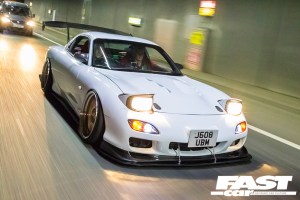
Mazda RX-7 FD Tuning: Drivetrain Upgrades
The FD RX-7 gearbox and rear differential is overall a strong and capable setup, with a precise gear change and Torsen limited slip rear diff, which combined with the relatively low torque levels of the rotary engine means – aside from the clutch – the factory parts can handle quite significant power upgrades. There’s plenty of FDs driving around with over double the factory power levels running standard gearboxes and rear diffs, but that’s not to say upgrades aren’t available or needed, as they certainly are.
Gearbox
Gearbox upgrades range from uprated gear sets for the standard box, like the OS Giken kit, to complete gearbox swaps, to sequential race gearboxes that have always been very popular in FD circuit race cars. There’s now even a full sequential conversion kit available from Domi-Works to run the BMW paddle shifted DCT transmission in rotary engine FD RX-7s!
Differential
The factory LSD differential is good, but it can be made better! Aftermarket upgraded LSDs are available, and they generally are clutch plate type diffs, which generally gives a more consistent performance and improved traction, at the expense of some mild noise and drivability issues as plate style diffs can be a little clunky during low-speed cornering.
Uprated driveshafts exist for the factory rear diff setup, but when it comes to handling gigantic levels of torque and grip without smashing the diff itself, there’s aftermarket solutions available, albeit very expensive ones! There are kits available in the USA to convert the FD rear end to the Ford 8.8 or even the Ford 9-inch rear diff setups, which keep the fully independent rear suspension, but adds a differential and driveshafts that are practically unbreakable even with more power than most could ever dream of.
Clutch
Clutch upgrades are needed for any significant power increase, but they’re widely available from the likes of Competition Clutch, Exedy, and many more, from mild upgrades right through to multi-plate items that can handle much more grunt than the gearbox itself can.
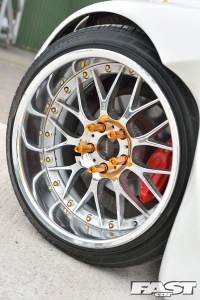
Mazda RX-7 FD Tuning: Brake Upgrades
From the factory, the FD RX-7’s brakes are actually superb, some of the best in the world when the car was new, and even today they’re very impressive. As a result, many people stick to uprated pads and the standard sized discs and calipers on tuned road cars, but if you want big brakes for track use, or even just because they look awesome behind the spokes of your wheels, there’s plenty of options out there. AP Racing, StopTech, K-Sport, Wilwood, Brembo, Tarox, and more, all make big brake kits for the FD RX-7, which along with the right pad combination, are enough for even the hardest-used circuit race or Time Attack cars.
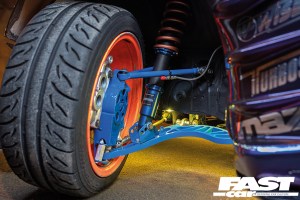
Mazda RX-7 FD Tuning: Suspension Upgrades
The FD RX-7 is considered one of the best handling cars of its generation, and certainly can hold its own in standard form even today. Much more impressive though is the potential when upgraded. Even now in 2022, modified RX-7 race and Time Attack cars are class winning beasts against much newer opposition, and thanks to the inherently good design they leave the factory with, upgrades are relatively simple.
Shocks and springs
While basic lowering springs are available for the car, most people go directly to a set of coilovers, enabling them to get the ride height exactly how they want it while also hopefully improving handling. Almost every aftermarket suspension manufacturer you can imagine makes coilover kits for the FD, from cheap unbranded units to popular middle ground units such as HSD and BC Racing, to high end coilover brands such as Ohlins. Your choice will effectively boil down to both budget and your goals for the car. Bear in mind that coilover setups designed for track use will be set up to be very stiff versus something designed to be more compliant for road use, so take note of their intended use and spring rates before buying!
Suspension arms
The car comes with double wishbone front and rear suspension, which is a good start when it comes to performance, but there’s not a lot of adjustability from the factory aside from limited front and rear toe changes. A solution to this is adjustable arms from the likes of Hardrace who do a complete front and rear kit for these cars. As well as allowing a wide range of camber, castor, and toe adjustment, they come with rose jointed ends, removing any slop found in the standard ends which are rubber bushes. While not strictly a suspension arm, rear diff braces are considered almost vital on big power cars, especially ones that are launched hard, as they keep the rear end components firmly in place, which drastically reduces wheel hop and helps prevent the factory power plant frame from cracking.
Poly bushes
For fast road use, fitting adjustable arms with rose jointed ends is overkill, but replacing the soft and most likely worn rubber suspension bushes with polyurethane items will help the chassis feel a lot tighter and more responsive to your inputs for a relatively low price. Powerlfex and Whiteline do full front and rear kits, including for the rear differential and steering rack mounts, and with all of these fitted an old car literally can feel better than new.
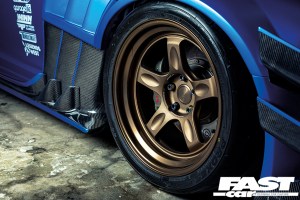
Mazda RX-7 FD Tuning: Wheels and Tires
One of the few components that hasn’t aged too well is the wheels, which generally are small and dated, and even the ‘best’ wheels – the 17-inch BBS wheels from the late Spirit R model – are pretty tame. Thankfully, even the standard FD arches are quite spacious, so 9.5×18 wheels with an ET20 offset, combined with fairly substantial 245 wide front and 265 wide rear tyres fit with no issue at all, fill the arches nicely, and can give massive amounts of grip.
If you want ultimate examples of tire setups for RX-7 track cars, look no further than the countless time attack monsters that compete at Tsukuba in Japan. Generally, they run a square setup, i.e. the front and rear tyre sizes are the same, with the majority of them running 255/40×17 or 265/35×18 tires front and rear on standard arch cars, and usually around 295-wide when they fit aftermarket wide arches to suit. Of course, wider tyres have been fitted, 335s front and rear for example, but sticking with the Tsukuba theme, you’ll notice the lap times don’t magically fall with the wider wheels. Instead, most of the slightly narrower-tire cars lap as fast or faster than the wider ones…
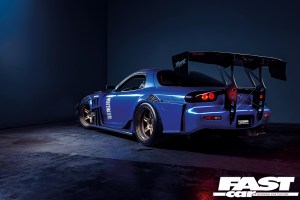
Mazda RX-7 FD Tuning: Styling upgrades
The FD RX7 is without doubt one of the best-looking standard cars to ever come out of Japan, and considering it’s now thirty years old, the looks have aged incredibly well and it’s still a stunning and modern looking car. That doesn’t mean you should leave it looking standard though, as things can still be improved, and thankfully, there’s no end of options out there for you.
If you want a subtle OEM+ style look, late spec bumpers and spoilers freshen up the look no end, though prices can be high for sought-after late-spec parts. Alternatively, the aftermarket has created so many kits for the FD – there’s tons of other options.
Stock body, wide body, subtle, insane, the world is your oyster and there’s way too many styling upgrades to list here, but RE:Amemiya have tended to create the nicest overall range of kits that have aged well and suit everything from a race car to a show car.
A vented bonnet to help get the hot air out and the cold air in is a good move also, and there’s plenty of versions available. Seibon make vented carbon bonnets and even full carbon doors for the FD for anyone who wants to save weight or really stand out from the crowd.
For smaller touches, aftermarket front and rear lights are available, including fixed headlamp conversions from the front, though prepare to be shocked by some of the prices; a set of Car Shop Glow rear lights imported from Japan will end up costing around £2500 mark and have a long waiting list as they are custom made to order!
Words by Stav.

